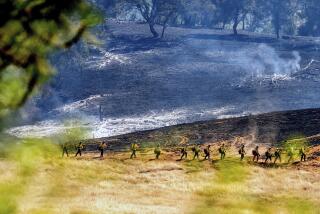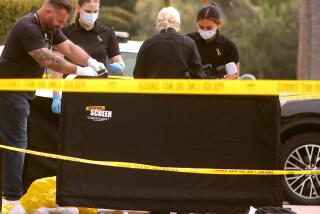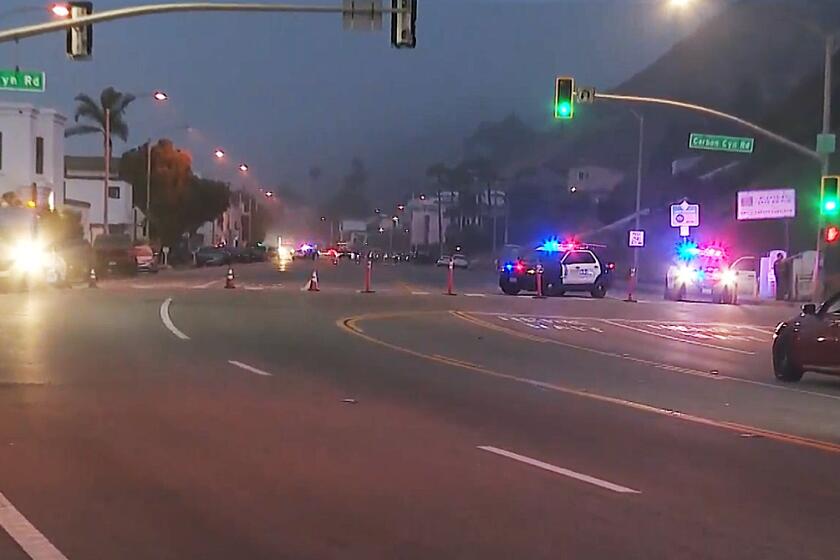Struggling Toward a More Diverse LAPD : Bias: Efforts to hire blacks and Latinos have made strides, but recruitment of women lags far behind goals.
Stan Embry, a tall, rangy African American, was a rookie cop on patrol in West Los Angeles when his white superior gave him a basic course in crime fighting and racism, LAPD-style.
“Any time you see blacks running around West L. A., that’s a traffic stop,” he was told.
Embry, more willing to speak up than most probationers, chastised his training officer for assuming all blacks were potential criminals. “That’s wrong,” he said.
“I know bad guys,” his superior snapped.
Seventeen years later, Embry had become a lieutenant in charge of vice operations in the San Fernando Valley, and is on a career trajectory carrying him into the upper ranks of LAPD management. He proved his mettle in the Northridge earthquake, rallying cops with a hand-held radio from a command post set up on a street corner while transformers exploded overhead.
His former training officer, never promoted, is still on patrol.
Embry is a success story in a department that is struggling to rebuild itself from the ground level, to shed its image as a frat house for blue-eyed men with crew cuts.
Of all the mandates for change clamoring for attention within the LAPD, the drive to broaden the ethnic and gender makeup of the force may be the most imperative. The lack of diversity has been tabbed by department critics for everything from the Rodney G. King beating to the harassment of minority communities.
Proof of how indelible the image has become is the defense gamble in the O.J. Simpson case that the jury will believe LAPD investigators are capable of planting evidence and forming a massive, racist conspiracy to cover it up, something that would have seemed ludicrous only a few years ago.
Surprisingly, considering its public image, the white male is a minority on the force at 46.1%. The number of black officers is less than a percentage point under the 15% hiring goal set by the city. Latino officers now make up 25.9% of the force, less than five points from the target.
The changes are apparent in the roll-call room in Van Nuys, where the ranks of probationers who sit solemnly in the front rows swell with female and minority recruits. The division’s youngest training officer, Alan Hamilton, is black.
“There have been changes, moves in the right direction,” says Embry, who recently was promoted Downtown. “We’ve got police officers I don’t think much of. But there are far more outstanding officers out there.”
So how far along is the LAPD in its rebuilding process? “Farther along than the community perceives it to be. And the national media,” says former Police Commissioner Gary Greenebaum. “It’s starting to look like the city.”
That doesn’t mean bias is as outmoded as the chokehold. When a white cop hears one day that his partner’s son is entering a karate tournament in mostly black Lake View Terrace, he makes a joke that evokes the most vicious passages of the Christopher Commission report on LAPD racism.
“He’s going to be fighting a lot of hoo-hoo-hoos ,” the man says, scratching under his arms like an ape, recalling the infamous “gorillas in the mist” radio transmission that became a worldwide example of LAPD intolerance.
And while hiring goals for minorities are within reach, the target of making the department 43% female will not be achieved, at the present rate of growth, until 2022. Activists are angry.
“It’s bunk that there aren’t women clamoring for these jobs,” said Katherine Spillar, national coordinator of the Feminist Majority Foundation and a former co-chairwoman of the Police Commission’s Women’s Advisory Council. “The department is deliberately not recruiting them. We had to force them to stop looking at Marine bases and go to child-care centers.”
In Los Angeles, where officers proportionately kill or wound more civilians than any of the nation’s other five largest cities, according to a 1991 study, the failure to bolster the ranks of female officers is costing taxpayers millions, says Spillar. “Women de-escalate situations,” she said. “When you look at the payouts on excessive use of force, there are no payouts on women.”
Further, though the lower ranks have become more diverse, the command structure remains mostly male and white. Of the 94 officers at the rank of captain and above in 1994, 73 were white, which is actually an improvement over the situation five years ago, when 81 of 93 were white.
Statistically speaking, the LAPD is about halfway through its metamorphosis. That doesn’t mean the pressure on the department has eased. In some ways, it has increased. Now, it is being tugged in opposite directions by those who feel the department is still resisting change, and those who think it has sacrificed public safety for political correctness.
“As a white male, I am worthless,” says Dan Drulias, 28, a patrol cop who won a coveted Medal of Valor several years ago for crawling into a burning building to rescue people trapped inside.
Resentments of white males are not paranoid fantasies. To pass the oral exam, the first crucial step toward becoming a Los Angeles police officer, a white male must score nearly a perfect 100, while Latinos need only an 85 and women a score in the 70s.
Now, in order to further bolster the ranks of female officers from the current level of 16%, there has been serious discussion about removing a requirement that recruits climb a six-foot wall as part of the test for physical agility.
The issue became a rallying point for officers defending the old standards.
“If they can’t climb that wall, they don’t belong on the goddamn job,” says David Cueto, a Latino officer who was part of a delegation that took its concerns to the Police Commission late last year. If he chases a suspect over a fence, Cueto doesn’t want his partner stuck on the other side.
The complaints about the new recruits don’t stop there. Joanne Needham, a respected motorcycle cop, complained that many recruits, men and women, are smaller and less physically able.
“A simple thing like a drunk on the ground, they can’t even pick them up,” she said.
The chief himself--the first African American to hold the city’s top law enforcement job--is a target for the accumulated vitriol.
“This isn’t the chief of L. A.,” a cop shouts out at roll call one morning when someone asks if a job opening requires applicants to meet physical fitness standards. It is a direct slap at Willie L. Williams, whose substantial girth has come to symbolize the new, softer element in the LAPD, derisively labeled “the Pepsi Generation.”
“Brutal,” Embry jokes. “That’s why I’m not going to run for chief.”
While Darryl F. Gates was sometimes a target as chief, it is much more true of Williams. Embry says there are several factors involved. Many have never forgiven him for not coming up through the ranks. His recent problems over allegations that he lied to the Police Commission over whether he accepted free hotel rooms in Las Vegas has inflamed the critics still more.
But Embry believes race is a factor too. “They’re quick to take shots at the chief,” he says.
What makes the debate over the future of the LAPD so thorny is that there is no consensus on the past. Many of the old-timers bitterly resent the now widely held belief that the department routinely mistreated minorities.
They agree the department was aggressive in the old days. It had to be. Cops were spread thin even then. So they engaged in tactics designed to stop crime before it happened, many said.
When Sgt. Joe Cupo, a thin-haired, chain-smoking, finger-pointing ex-New Yorker, was hired in 1966, he believed he had become a part of the world’s finest organization.
“It was awesome,” he said. “I had to say, ‘Pinch me.’ ”
“When I came on, the LAPD standards were extremely high,” he said, leaning over the hood of his patrol car in a mall parking lot. “Way higher than today.”
The department had the support of the city, and officers knew they had the authority to arrest anyone, whether a baseball star or a county supervisor. “Look at the O.J. trial. Do you think in ’66 he would have been on the streets three days and able to head to the border? In ‘66, he would have been in jail, the first day.”
Told of Embry’s experience as a rookie, Cupo denied that the department was abusive or that its faltering reputation today is retribution for past sins against minorities. “Supposing the facts were, 85% of the crime in Westwood was committed by young blacks?” Cupo asked. “Would that still be racist” to stop them?
The answer is yes.
A computerized breakdown of robbery reports in Van Nuys over a four-month period last year show that 43% of the 1,227 suspects were African American, 10% were white, 46% were Latino and 1% were Asians and others. The population of Van Nuys is 5% African American and 34% Latino.
The disproportionate share of crime committed by minorities presents law enforcement with a problem. But using that as justification to go after anyone who looks different is no longer acceptable. It also is no longer even practical, now that the department contains many Embrys, who remember what it was like to grow up feeling harassed, to be “proned out”--flat on his face--for knocking on his neighbor’s door.
Cupo thinks he has an answer to the LAPD’s political problems. “We used to be an extremely aggressive department. Given that we can’t do that anymore, we have to adopt the New York Police Department policy. You need thousands and thousands of officers. When they have a demonstration, they put one cop for every demonstrator. Two thousand demonstrators. Two thousand cops.”
Symbolic of the change that has taken place inside the LAPD, younger officers such as Alan Hamilton, 30, haven’t had the same experience as Embry or vice Sgt. Nick Wade, who still bristles when he recalls his first partner using “the N-word” around him.
Hamilton, a spit-and-polish black man who speaks Spanish and combines outstanding communication skills with physical bravery, says he has never experienced a hint of racism.
“It’s so overblown it’s ridiculous,” he says of the issue.
Latino officers have experienced the same barriers and frustrations as their African American colleagues.
“The department was very, very, very racist” when Joe Aparicio came on 27 years ago. One of the first Latino officers to be assigned to the mostly white San Fernando Valley, Aparicio had such a difficult time that he wrote a 500-page book about his trials. Aparicio, now a detective, never published it, but it is filled with the remarks and jokes that he endured.
Comments like, “You speak English good” were routine, he said. “You were not supposed to be thin-skinned,” he said.
And just as with African American officers, younger Latinos have had an easier time. “All my experiences have been positive,” said Sgt. Ralph Morales, a 12-year veteran who supervises training in Van Nuys. “All I’ve seen is support.”
Today, the prime affirmative-action battleground is the role of women on the force. In Van Nuys, female officers make up 20% of patrol, and the department as a whole is increasing its proportion of female officers by roughly 1 percentage point every year.
Penny Harrington, the former police chief of Portland, Ore., and director of the National Center for Women and Policing, said the debate over things like the wall merely obscures the real issue--keeping women out.
She said the wall was introduced only after height requirements were dropped. “When we got the height requirements eliminated, what do you know? The damn wall pops up,” she said.
In the past five years, six women have alleged that they were raped by male colleagues, some in the Police Academy. Few women in Van Nuys reported any incidents of harassment.
“I have never, ever been a victim of discrimination,” said Peggy Moseley, a slender detective with glasses who drinks from a coffee mug that says: “It used to be a man’s world and a woman’s place was in the home. They can kiss that shit goodby.”
Moseley is not afraid to stand up for herself. She once shot a man who grabbed her partner’s gun and wouldn’t let go. “He sits in a wheelchair and pisses in a bag,” she said.
She suffered no ill effects from her encounter. “I didn’t start drinking,” she said. “I didn’t stay up late.”
Far from being distant or hostile to the male officers, female patrol officers express similar complaints--anger toward a city that doesn’t support them and hostility toward newcomers who try to get out of the patrol cars and into a desk job.
“A good majority of women want to get out of the field as soon as possible,” said Kim Peterson, 27, who is proud of the fact that she has been in patrol her entire six-year career.
She said many of them have a rude awakening when they get into a physical struggle the first time. “Two female officers told me they don’t ever want to go back to the field,” she said.
She says many new female recruits are thin-skinned.
“There is nothing you can say that will offend me,” she said. “I see dead bodies. I see dead children. These women that come on the job and get offended [by something their partners say]. Come on, woman.”
To Harrington, these comments fit a familiar pattern.
“Women who got there first had to learn how to survive,” she says. “The women who come on later will not put up with the stuff prior women put up with.”
Homicide Detective Roberta Moore, a thin, erect woman who wears her blond hair swept back, recalls her own trial by testosterone.
Her first partner told her she should be home “barefoot and pregnant.” Her next partner assumed she would back off in a fight. That changed after their first call together, a domestic violence situation requiring the use of force.
Moore jumped right in. Her partner softened and began to rely on her talent for communication to solve disputes that he once settled with his fists. He was pleasantly surprised, as were his superiors, to find that personnel complaints from the public disappeared.
Studies have shown that women have a calming effect on police work. The Christopher Commission noted that none of the 120 officers most frequently charged with excessive use of force were women.
As the LAPD struggles toward some still-undefined future, it is clear that both men and women are paying a price. Some men, especially those who have reached middle age and have not advanced, find their futures closed off and grow sour.
Trailblazing female officers such as Linda Gotham, a 5-foot, 11-inch surfer, are caught in the middle. Gotham never had ulcers until she became a cop six years ago. Now, the 35-year-old officer says, she has “major ulcers” and “eats Tagamet like candy.”
She recalled an altercation with a man who had just blackened his wife’s eye. She had the cuffs half on when he “went off.” While she rolled on the floor with the man, her female partner stood there saying, “Now sir, you’re going to have to come with us.”
After Gotham got the cuffs on, she confronted her partner. “What do I have to do, get hurt?” she demanded.
The other officer said she was afraid of being sued.
But Gotham has harsh words for the men too. When she doesn’t have anything else to do, rather than take a snack break at a doughnut shop, she impounds run-down vehicles. Citizens appreciate her getting the junk cars off the streets, but her male colleagues tend to disdain such low-impact police work. “You say you want to impound some vehicles and they’ll say, ‘Oh jeez, really?’ ”
Even worse are the John Wayne types. One colleague liked to carry around a .38-caliber, long-barrel gun that was not department-issued.
“Isn’t it cool?” the man bragged. “This is a man’s gun.”
“I don’t want you rolling on my calls,” she told him.
A 1990 study of the New York Police Department supported Gotham’s comments about male gunslingers. The study found that women fired their guns less than half as often as male officers.
“There are officers who are ineffective that are women as well as men, as well as blacks, as well as Asians,” said Capt. Richard Meraz, commanding officer of the department’s Employee Opportunity and Development Division. “A male officer has something to offer in a given situation. A female has something to offer. The best combination is a male and female.”
While the LAPD is a much more diverse organization than it was when Jack Webb’s steel-reinforced posture and clipped dialogue defined police work in Los Angeles, it will take time to convince the public, especially minorities, that anything has changed.
One cold December night, police are called to the scene of a domestic dispute involving a 38-year-old hospital worker who is holed up in his apartment. He is said to be armed with a .22 pistol and had told his wife, “If you call the police somebody is going to get hurt.”
Anticipating a hostage situation, Lt. Albert Dravidzius drives out to supervise. The man has no record. “This is one of those guys who’s been good all his life,” Dravidzius tells a small circle of officers gathered in front of a park half a block from the apartment building.
“He’s been having problems,” Dravidzius says. “He got a letter from his son in prison. He’s emotionally distraught.”
Suddenly, the man scrambles out of the parking lot in a small car. He tries to escape down a side street, but Hamilton catches up in his patrol car. The suspect, a tall African American, stops and gets out, but ignores repeated commands to lie down. Finally, Hamilton and another officer tackle him.
The police find out he is unarmed. Although he could have arrested him on any of several charges, Dravidzius decides to give the man a break. Running from the police is “not smart,” Dravidzius says, then lets him go.
The restraint shown by the police did not impress the suspect.
“You guys know what you did for Eulia Love,” he says, referring to the black woman who was gunned down by police in 1979, the first high-profile case focusing attention on the LAPD’s treatment of minorities. “You shot her over a gas bill.”
(BEGIN TEXT OF INFOBOX / INFOGRAPHIC)
Behind the Badge
From the Christopher Commission to the O.J. Simpson trial, the Los Angeles Police Department is in the line of fire as critics challenge its competence, and its integrity. Times journalists John Johnson and Joel Lugavere spent three months in the Van Nuys Division, one of the city’s busiest, to find how well police officers serve and protect as the department struggles to redefine itself.
SUNDAY: Shedding the past for an uncertain future
MONDAY: A crusader for crime’s smallest victims
TODAY: Diversity or division--the new struggle for equality in blue
WEDNESDAY: Homicide--a killing season
THURSDAY: The thinning blue line and the resource crisis
(BEGIN TEXT OF INFOBOX / INFOGRAPHIC)
Race, Gender: White Male Fraternity?
The popular conception, reinforced by some high-profile trials, of the LAPD as a club for white males is wrong. The white male today is a minority of the force and the department is nearing hiring goals for African American and Latino officers. The command structure, however, remains largely male and white.
ARRESTEES
Total male and female arrestees. Increase in proportion of female arrestees, 1987-1993.
Year Male Female % Female 1987 38,754 6,873 15.1% 1988 41,454 7,748 15.7% 1989 46,733 8,685 15.7% 1990 47,828 8,994 15.8% 1991 44,455 8,649 16.3% 1992 42,207 8,148 16.2% 1993 36,820 7,624 17.2%
****
FEMALE OFFICERS
Increase in proportion of female sworn personnel, 1987-1994: 1987: 8.9% 1988: 11.1% 1989: 11.9% 1990: 13.2% 1991: 13.6% 1992: 13.9% 1993: 15.1% 1994: 15.9% ****
ETHNICITY OF OFFICERS
Present force makeup: Ethnicity of 1994 sworn personnel: White: 54.5% Hispanic: 25.9% Black: 14.8% Asian American: 4.7% Other: 1.2% ****
The Trend: A decrease in the proportion of white sworn personnel shows a trend toward more ethnic diversity in police force. 1987: 69.3% 1988: 66.7% 1989: 64.1% 1990: 61.4% 1991: 60.5% 1992: 59.2% 1993: 57.2% 1994: 54.8% Source: LAPD
More to Read
Start your day right
Sign up for Essential California for news, features and recommendations from the L.A. Times and beyond in your inbox six days a week.
You may occasionally receive promotional content from the Los Angeles Times.






